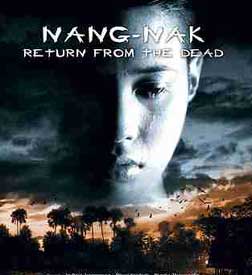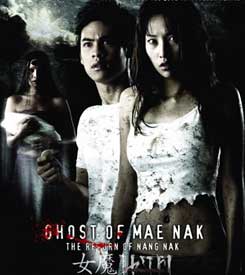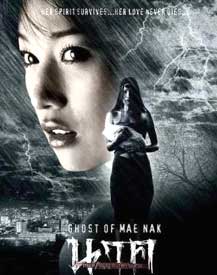It's interesting how nearly entirely Thai this The Ghost of Mae Nak (2005) feels even with the writer-producer-director-cinematographer being British. There are a few western-style or western-attitude interpolations, but one sees this sort of international influence even from Thai directors, & over all, if I'd been told this one too was from a Thai director, I'd've never thought to question it.
It's also impressive that as an Independent film with Mark Duffield personally filling so many of the behind-the-camera roles, it manages to look like an A film rather than something done on the cheap.
Although this is Duffield's feature-length directorial debut, he had previously directed short subjects, & had been around some while as a cinematographer. So he knew how visually to get the most out of a budget. In Thailand he had access to state-of-the-art equipment, well known actors, & highly skilled film crews in whom he placed considerable trust, to good outcome.
Duffield has also been a long-time horror fan & had been developing scripts for some while, none previously produced. As a writer he had a real breakthrough on the script for The Ghost of Mae Nak. He'd gone to Thailand originally as cinematographer for Butterfly Man (2001) & afterward began research for Mae Nak.
 Building from a traditional ghost story that is extremely well known in Thailand, the majority of the many Nak stories have a "tragic love story" heart, but now & then, as in Nonzee Nimibutr's film Nang Nak (1999), the ghost becomes horrific. Duffield grabs some of Nimibutr's film for the flashbacks to the days when Mae Nak lived, & first died, & it makes me wonder what Nimibutr thought of his appropriation. Building from a traditional ghost story that is extremely well known in Thailand, the majority of the many Nak stories have a "tragic love story" heart, but now & then, as in Nonzee Nimibutr's film Nang Nak (1999), the ghost becomes horrific. Duffield grabs some of Nimibutr's film for the flashbacks to the days when Mae Nak lived, & first died, & it makes me wonder what Nimibutr thought of his appropriation.
As effective as I found this newest version of an often filmed legend, I can't let it pass unnoted that in Nang Nak was the better film, because it is much more than a horror film. It's a genuine work of art. It's worth looking a bit harder for "the director's cut" available subtitled, & carrying a lengthened title on the box, Nang-nak: Return from the Grave.
It was by far the most popular film in Thailand its year of release, & took a dozen film awards. Its lush riverside jungle photography is bound to remind American viewers of the Louisiana bayou. There's a powerful realism to the film because everyone looks like they really existed in a time past, & no concessions are made to modern fashion. We're legitimately thrown into another world, one that even modern Thais have found amazing.
In the 19th Century, Mak (Winai Kraibutr who luckily launched his now-vibrant acting career with this his first film) is conscripted & sets off for war. His young wife Nak (Intira Jaroenpura of an acting family) was left to fend for herself, & ends up dying in childbirth. Yet when Mak returns from war, he finds his wife & child are fine, & they pick up their lives as before, to the horror of villagers who know how Nak died.
Nak's emotional neediness & faithfulness, & the horrific repercussions of her lingering existence, are deeply moving even while frightening. The monk who does battle with her spirit pits the standard Buddhist attempt to eliminate illusion against Nak's deep abiding love for Mak which empowers her to sustain illusion.
The most grim aspect of the exorcism is the removal of a piece of Nak's forehead to make a charm the monk will keep with him always. What justifies Duffield's "sequel" is the very interesting question of what became of that relic/charm.
The idea of the forehead bone charm seems to originate in Nonzee Nimibutr's film, though I'm uncertain of that. Most versions of the story assert than Mae Nak is captured in a bottle.
In Thailand this is regarded as a true story & a temple exists to Nak's honor. She is prayed to like a divinity, a bestower of good fortune. Even director Nonzee Nimibutr made appeasing offerings to the Nak's Mahabut temple & to other Nak shrines so that she would bring good luck to the production, & she must've done so because it's a great film, & a big commercial success for Nimibutr.
Rather than a true tale, however, it is of course traditional folklore & can be found retold throughout Asia in one form or another. A version is represented in Masaki Kobayashi's anthology film Kwaidan (1964). The episode called "Black Hair" is about a samurai who returns home to find nothing changed, though in reality the house is in ruins & his wife long dead. Part of Kenji Mizoguchi's Ugetsu monogatari (1953) is another variant.
It's a far better basis for an aesthetic ghost story than the great plethora of soggy girl demons & evil ghost-children & haunted telephones & video cassettes that have come to dominate modern J-horror & its imitations in Korea, China, Thailand, & the United States.
 The main, modern story for the "semi-remake" or sequel The Ghost of Mae Nak is about a young married couple who have the same names as the famously doomed 19th Century couple. Nak (Pataratida Pacharawirapong aka "Tangmo," a popular soap star) has recently married Mak (Siwat Chotchaicharin, a pop singer turned actor).
The main, modern story for the "semi-remake" or sequel The Ghost of Mae Nak is about a young married couple who have the same names as the famously doomed 19th Century couple. Nak (Pataratida Pacharawirapong aka "Tangmo," a popular soap star) has recently married Mak (Siwat Chotchaicharin, a pop singer turned actor).
They're offered a great deal on an old, old house on the edge of Bangkok. When ensconced, they discover it is haunted. The love of the modern Nak & Mak awakens the spirit of Mae Nak, whose spirit is bound to a bone charm made by the monk (Prasert Thonglin) who in a previous century laid her ghost.
It is only in the flashbacks that Nonzee Nimibutr's version of the legend is "borrowed." The ghost of Mae Nak (Porntip Papanai) awakens in the modern world desparately wanting to be freed to reuinite with her lost love, Por Mak (Jaran Ngamdee), or she will (whether or not inadvertently) destroy the modern lovers.
There is no escaping Mae Nak. Moving out of the house will not help. In her own way, she "protects" the couple, though she is also inevitably a threat to them. Real estate agent Mr. Angel (Meesak Nakarat) attempts to take advantage of them, & gets his head ripped off in a subway.
Two thieves (Charay Mutpayoon misnamed Tick & Sanit Pengprasop misnamed Tock, in one of the film's few western-director jokes) break into Nak & Mak's house & steal all the wedding gifts. Mae Nak's powerful spirit pursues them to revengeful & appalling demises.
Most gruesome of all (yet also kind of prettily done) was the doom of the troublemaking butler/housekeeper (Nirun Changklang) of the Master Tring (Thanapath Si-Ngamrath). He literally gets cut in half from head to crotch, in one of the grossest gore FX ever, the more gruesome because the film has such an aesthetic rather than exploitation tone & look.
In the flashback story to the 19th Century, Mae Nak & Por Mak live an idyllic life in the Siamese jungle. Mak gets drafted, & in his absence at war, Nak is raped & killed. Yet when Mak returns from war, he finds his wife & child alive & well, & picks up their idyllic life anew.
When villagers interfere with the illusion the ghost of Mae Nak has created for her family, she kills them most brutally. So a nearby monastery intervenes to lay her spirit, the strongest exorcist monk cutting a piece of bone out of her forehead to turn into a charm.
As the modern story progresses, the bone charm made from Mae Nak's forehead comes into newlywed Nak's posession. She must find the secret place of Mae Nak's bones & restore her forehead, or her husband Mak, in a mysterious coma, will never awaken.
In the meantime, the manifestations of Mae Nak are ultra-horrific. There's an element of J-horror "scary woman with long hair" to Mae Nak, but the Japanese version usually has a degree of beauty or sexiness, as though for Japanese film goers it is sex that is scary rather than death. Mae Nak with the hole in her forehead & her enormous vortex of a mouth is just straight-out horrific.
The main young actors do a great job & have real talent. But they're frankly upstaged by an array of support & character actors with wonderful faces. When the grandmother (Marasri Issarangkul Na Ayutthay) takes the young couple to meet an old blind woman (Wattana Koomkrong) who can communicate with the spirit world, every character except the main stars are maximumly credible & provide convincing windows into Thai folk belief.
It's a fine adventure, a fine suspense tale, & a highly effective ghost story. It's not a flawless film, however. For example, there's one of those peculiarliy western codas to the film: After everything resolves reasonably & the story should be over, the ending turns out not to be the ending after all.
There is tacked on to the last half-minute what amounts to a "ha ha! fooled ya!" eradication of the film's entire point. This is an awfully cliche way to end a film. If a film is already cheezy-trashy, it might as well have one of these ha-ha Boo! codas, but Ghost of Mae Nak was such a good film until then.
copyright © by Paghat the Ratgirl
|


